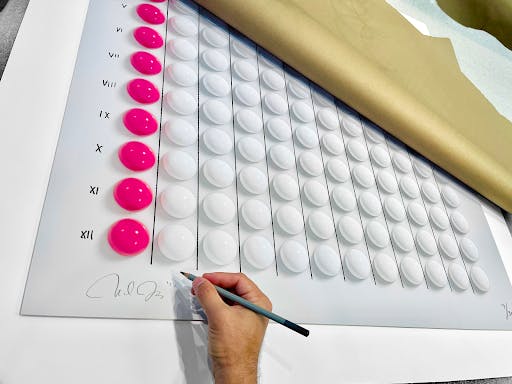An experimental 300-piece collection from Yuga Labs on the Bitcoin blockchain
Today we announced an original and experimental 300-piece generative art collection inscribed onto satoshis that will live on the Bitcoin blockchain: TwelveFold.
Satoshis are the smallest individually identifiable units of a Bitcoin. An inscribed satoshi can be located by tracking when that satoshi was minted in time via the Ordinal Theory protocol. Inspired by this, our collection explores the relationship between time, mathematics, and variability.
When measuring time, the calculation base used is not uniform and varies from base 60 (60 seconds in a minute, 60 minutes in an hour) to base 12 (12 months in a year) and so on.
TwelveFold is a base 12 art system localized around a 12x12 grid, a visual allegory for the cartography of data on the Bitcoin blockchain.
The collection includes highly-rendered 3D elements as well as hand-drawn features which serve as an homage to the ordinal inscriptions currently done by hand.
All of these choices are a departure from what’s expected from Yuga.
But, you know. Fuck doing expected things.
Wait, what is an ordinal inscription?
Bitcoin is a fungible digital currency, but a Bitcoin Improvement Proposal (BIP) described a method, called inscribing, that allows creators to connect data to an individual satoshi (1/100,000,000th of a Bitcoin) and host metadata (particularly the artwork) on-chain. In effect, this enables satoshis to operate as if they are non-fungible, essentially enabling the concept of NFTs on the Bitcoin blockchain.
Stepping into the Ordinals Discord a month ago felt like getting a glimpse of the 2017-era Ethereum NFT ecosystem. It’s the type of energy and excitement we love at Yuga.
The infrastructure and tooling around inscriptions (or NFTs) on Bitcoin is rapidly progressing, but is still incredibly nascent. Much of the foundational principles that we look for are here: provenance, self-custody, ownership – but the tooling and structure we’ve become accustomed to with Ethereum NFTs isn’t present.
We expect this technology and the ecosystem around it to evolve and become more sophisticated over time, however, we don’t expect it to evolve in the same ways other blockchain NFT ecosystems have.
We’re excited about ordinal inscriptions and what the future holds for digital artifacts on Bitcoin.
The TwelveFold Puzzle Series

In February, we launched TwelveFold, a collection of 300 unique generative art pieces on the Bitcoin blockchain (holders, there’s something coming your way soon).
Now, we’re bringing TwelveFold to life in a new way through a collection of 13 cipher puzzles inspired by the artwork and open to all. TwelveFold holders, Bitcoin OGs, and puzzlers alike can take on this challenge for a chance at the prizes.
Starting today, we’ll be releasing one Moon Puzzle every week for the next twelve weeks. Each has a prize of 0.12 BTC for the first to solve it. On the thirteenth week, we unlock a final puzzle — the Sun Puzzle. The prize is a unique Twelvefold piece.
The TwelveFold puzzles stay true to the inspiration behind the collection — the relationship between time, mathematics, and variability. TwelveFold is a base 12 art system localized around a 12x12 grid, a visual allegory for the cartography of data on the Bitcoin blockchain. The 300 pieces are inscribed onto satoshis, the smallest individually identifiable units of a Bitcoin.
Any inscribed satoshi can be located via Ordinal Theory, a protocol that assigns unique serial numbers to and then tracks satoshis. (Each satoshi also has a unique “name” made up of letters that correspond to its serial number).
Using Ordinal Theory as the foundation for these puzzles wasn’t easy. Cryptographically verifying answers is possible on the Ethereum network via Etherscan, but that option doesn’t exist on Bitcoin. And creating a facsimile of Etherscan didn’t feel appropriate for this project. So we worked with Gamma.io to come up with a solution.
Following the Ordinals protocol, we’ll have people submit answers by inscribing them on satoshis. (If you’re new to Bitcoin inscriptions, the tutorials here will guide you through the process).
Befitting the universal inspiration behind TwelveFold, the puzzles themselves are for everyone. (Yes, this means many of the people working on these puzzles are being onboarded to Bitcoin, so let’s give them a warm welcome.)
How it works (more details in the FAQ):
- "To participate in the puzzles, you’ll need an Ordinals bitcoin wallet. If you don’t have one yet, set one up by following this guide from our friends at Leather (formerly known as Hiro): Leather Set Up Guide
- Once you’ve submitted an answer, you’ll send a Bitcoin fee (likely ~$4-$8 worth depending on network traffic) to the address that appears in order to inscribe your answer onto a satoshi.
Here’s how it looks with a Leather wallet:
You get the idea. Whichever wallet you have, we’ll use your submitted Bitcoin to inscribe your answer on a satoshi and then check that answer for accuracy. More tutorials (and other helpful info) can be found in the FAQ.
The first person with the correct answer inscribed is the winner for that puzzle. If two people submit the right answer in the same Bitcoin block, we’ll accept the answer with the lower inscription number.
The first puzzle is now live. Begin at Twelvefold.io/puzzle